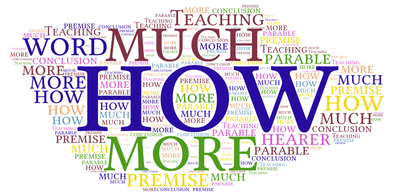
Back in the 1st Century, in the time of Christ, the renowned Jewish teacher Hillel and other scholars developed careful methods of logical argumentation in order to arrive at sound conclusions regarding interpretation of the Scriptures. One of those methods was called Qal va-homer (literally “light and heavy”), which argued from the lesser to the greater situation and which is often called the “how much more” argument. In other words, if X is the case, how much more would Y be the case.
We actually see this principle occasionally in the Old Testament. For example, after Miriam criticized Moses and was punished with leprosy, Moses prayed that she might be healed, but God reminded him: “If her father had spit in her face, would she not have been in disgrace for seven days? Confine her outside the camp for seven days” (Numbers 12:14) – in other words, if she would be punished for seven days for offending her human father, how much more should she be punished for seven days for offending God.
When we get to the New Testament we see the method of argument employed regularly by Jesus in his teaching. Not surprisingly, we see the most examples in the Gospel of Matthew, which seems originally to have been written in Hebrew for a primarily Jewish audience. The twelfth chapter of Matthew’s Gospel contains a clear examples of Jesus’ use of the “how much more” argument in the story of his healing of a man with a withered hand on the Sabbath day.
Before we look at that example, it is good to remember that in using the “how much more” argument, the Jewish scholars and rabbis utilized a common format. The argument was presented in three propositions: a first fact or premise, a second fact or premise, and a conclusion based on the two preceding premises. We see this when we read how Jesus replied to the Pharisees who tried to trap him by asking him: “Is it lawful to heal on the Sabbath?” (Matthew 12.10).
First Jesus told them: “If any of you has a sheep and it falls into a pit on the Sabbath, will you not take hold of it and lift it out?” (Matthew 12:11 – the first premise). Then he continued: “How much more valuable is a person than a sheep!” (Matthew 12:12a – the second premise). Finally he concluded: “Therefore it is lawful to do good on the Sabbath” (Matthew 12:12b – the conclusion). Notice that in the parallel account of this event in Mark, that Gospel records a different type of argument made by Jesus at this time that would have satisfied the congregation of the synagogue, but would not have been as effective in combatting the religious leaders – the Pharisees (Mark 3:4).
But in Matthew, Jesus not only answered the learned Pharisees decisively, he also did so using their own scholarly argumentation – their own method of scriptural interpretation. Jesus’ answer was thus not only a clear statement of the acceptable – and desirable – principle of doing good on the Sabbath day, it was also an indictment of the Pharisees for not reaching that conclusion themselves by using their own principles of exegesis.
Just as the “how much more” argument is found repeatedly in Jesus’ teachings, we find it also used by the apostle Paul, who was steeped in the scholarship of the Pharisees and trained by Hillel himself. Knowing this sheds extra light on many of the things that Paul writes. For example, in his epistle to the Romans Paul writes: “… if you were cut out of an olive tree that is wild by nature, and contrary to nature were grafted into a cultivated olive tree, how much more readily will these, the natural branches, be grafted into their own olive tree!” (Romans 11:24). Looking closely at these words of Paul, we see the same type of premise, “how much more,” and conclusion. Paul may sometimes vary this format, but the result of his argument is the same.
Remembering that the “how much more” argument was one used frequently by Jesus and Paul can help us to understand more about what they are saying when they use this form of interpretation. A pattern is certainly clear – neither Jesus nor Paul used this type of argument in a random manner. Most often it was used to clarify difficult questions or important points of doctrine. If we remember this when we are reading the Gospels or epistles of Paul, we can see why it is helpful to pay special attention whenever we see the words “how much more.” Once we know the principle and recognize it, how much more we can get out of many of its occurrences!
 RSS Feed
RSS Feed
